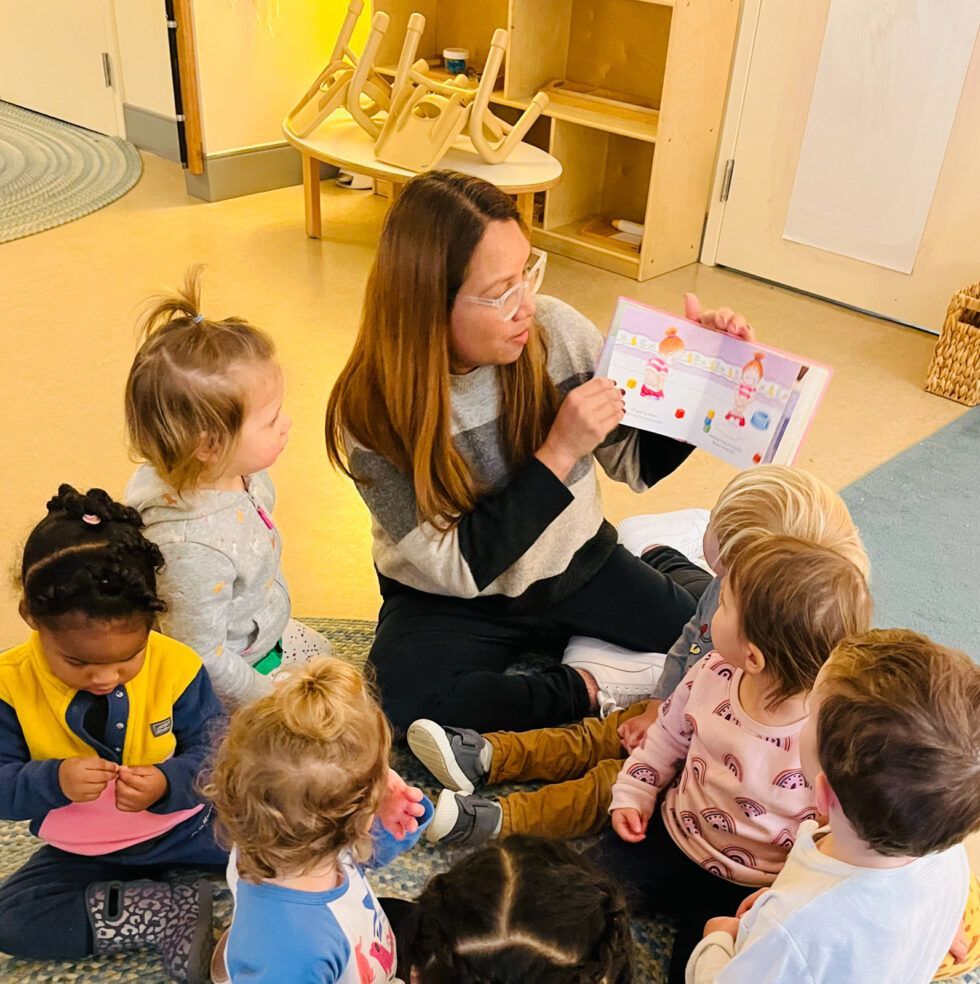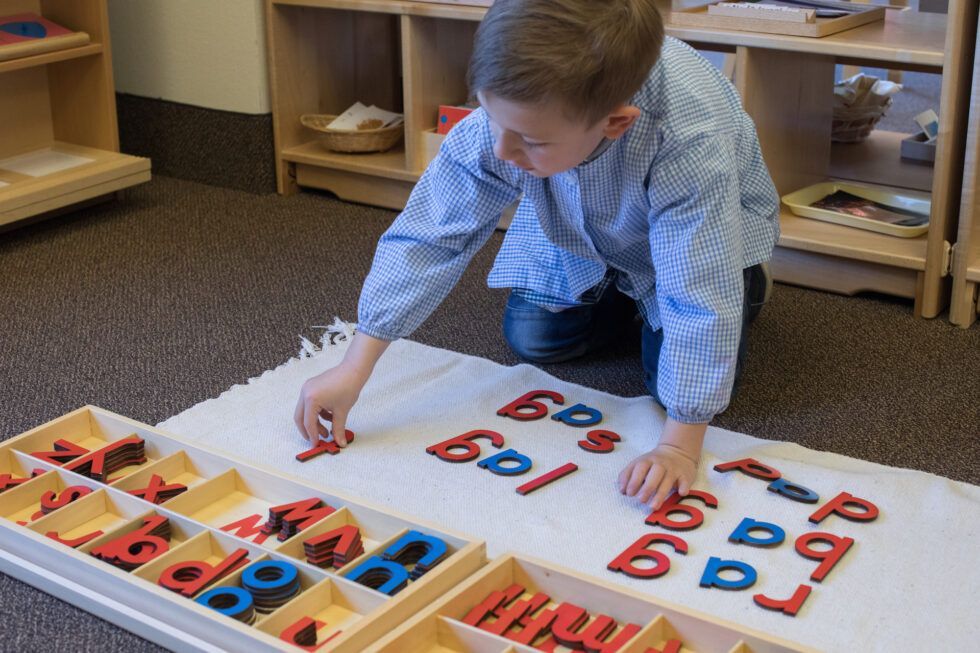Language

Our children’s early years are essential for developing strong language skills. So, in Montessori, we pay particular attention to how we support young children’s receptive and expressive language development. The exercises we use to enhance children’s spoken language development don’t have a large physical presence on the classroom shelves because many are games or conversations. These spoken language activities are a prominent part of children’s daily experience in our Montessori classrooms. The Purpose Young children are expanding their vocabulary at an astonishing rate: from recognition of about 50 words at age one, to about 1,000 words by age three, to at least 10,000 words by age five! We know that children absorb language effortlessly, so in Montessori we provide children with expansive vocabulary enrichment through a series of mindful oral language exercises. We also recognize that the adult is the most important language material in the classroom, so we use precise language whenever we are communicating with children. We offer rich, full, and beautiful language because we know we are providing an essential foundation for children. Our Favorite Activities We keep oral language alive and lively through a variety of purposeful activities. Classified Picture Books We choose wordless picture books that focus on a theme that is familiar to children or that are classified around a sequence (e.g., Amanda’s day). In the classroom, we sit down with one child and take a “picture walk” through the book to help the child interpret the picture clues. The adult doesn’t tell what is happening and rather asks the child about what they see. This process not only helps children develop their expressive language skills but also sets the stage for future reading and story interpretation. True Stories When we tell true stories, we invite a group of three to five children to join us. Sometimes we use little cultural artifacts or objects as we share stories about everyday life, or we offer little snippets about geography, art, music, biology, and geometry. The key to these stories is that they are based in reality and are not fictional stories. In sharing these stories, we offer children interesting and rich language, as well as spark their interest and imagination! The Question Game For this activity, we gather a small group of children who have a common experience. Then we ask a series of questions about that event. Being mindful to solicit answers from a variety of children, we focus on asking questions that can form a sequence and illuminate details. We then summarize the story based upon the children’s responses. Because children live in the moment and often don’t remember what happened yesterday, we try to do this activity on the day the common experience occurs. In addition to modeling how to tell a story and how to create complete sentences from one-word answers, we are also providing preparation for creative writing by taking an event and structuring it sequentially and highlighting details. Conversation at a Picture To engage children in this activity, we invite a small group to a piece of artwork on display and start a conversation about what the children observe in the picture. We focus on using “w” questions such as: What do you see? Where do you think they are? Why do you think…etc. We keep eliciting conversation by asking more questions: Do you see anything else in this area? Do you notice anything else about this scene? When the conversation begins to fade, we summarize the observations in a small narrative or story. Reading Literature We work to read quality children’s literature every day! When we do so, we highlight the book’s title, the author, and the illustrator. Under the age of six, children live in the present and are trying to adapt to the world around them. Because they are still too young to distinguish between fantasy and reality, we make sure to choose books that are grounded in reality. Reciting Poetry When reciting poetry, we do so from memory. We recite poems over a series of days and, just like with singing, children learn the poems by themselves and love to recite them. Children also absorb phonetic skills from any onset rhyme. Popular nursery rhymes support children’s process of learning to read! Objects in the Environment This activity is actually a series of games that follow a “listen and do” type format. After gathering a group of children, we explain that will say something to do and when a child hears their name, they get to do that action. We start with simple, one-step commands: Touch a shelf. Stand by a window. Walk around a table. We then progress both in complexity in terms of the types and categories objects as well as by offering double commands: Find a friend and shake hands. Choose a book and place it on a table. Play a bell and hum a tune. While quite fun, these games also have the added bonus of helping children develop their auditory memory. Classified Pictures For this work, we have collections of pictures representing categories of objects (types of transportation, furnishings, appliances, playground equipment, etc.), as well as cards with illustrations of geographical, geometrical, biological, and scientific terms (parts of a flower, land and water forms, polygons, etc.). When doing this activity with a child, we first name the classification (“These are all fruits.”) to help establish mental order. Then we play a little game to teach the vocabulary for the items pictured on the cards. The Sound Game The sound game helps children become aware of the phonemes in our language. We collect several known objects and play an I Spy type game that isolates the beginning sounds of the objects, then later the ending sounds, and eventually the sounds in the middle of the words. The whole purpose of this game is to help children become aware of the sounds that make up words. Spoken language activities are the foundation for children’s receptive and expressive vocabularies. In addition to enhancing their vocabulary and providing an overarching structure for future work in writing and reading, engaging children in language games also helps increase their listening and comprehension skills. Above all, we take the time to listen to children’s own spontaneous efforts to express themselves, so that they gain confidence in speaking and feel that their thoughts have meaning. Come see (and hear!) all this spoken language work when you schedule a visit. We love to share what we do!

Dr. Maria Montessori felt that in order to support children’s development of language, we first need to appreciate the evolution of language. In fact, the language today’s children use is a culmination of language evolution from the dawn of humans. Languages have expanded and grown to match the complexity of our cultures. Because language is changing and evolving, children create their language as it exists in their environment. Although a child born thousands of years ago had no less potential for developing language than a child today, our languages have grown in fullness and complexity. Evolution of Spoken Language Although we don’t have any records documenting the beginning of spoken language, we can imagine that certain experiences or events drove humans to produce different sounds. Over time these utterances likely became internalized and came to represent an experience. Language is necessary for humans to work together cooperatively. In his memoir, Born a Crime: Stories from a South African Childhood , Trevor Noah relates his experience growing up in South Africa, where there are at least thirty-five indigenous languages, eleven of which are official languages. As someone who speaks seven different languages, Noah experienced first-hand how language can bridge divides: “Language, even more than color, defines who you are to people.” Early humans developed language as a means of communication, but humans were isolated into small tribes or clans. Each group developed their own agreed upon communications. As populations increased and migration happened, communities came into contact. Some words got shared. Some new words were created. Etymology gives us the histories of the roots of words, and as such, historians can study the evolution of language and human migration through words and their roots. The vocabulary of any language is related to the culture of that community. For instance, the Eskimo language has 27 different words for snow, while Hawaiians have no words for snow. Languages constantly evolve as new experiences emerge in our culture. Currently, we can see this in how words are added or removed from the dictionary. A couple of decades ago, for example, “Google” was not a verb! Primitive spoken languages were primarily nouns interspersed with some adjectives, verbs, prepositions, and conjunctions. Primitive languages actually sounded a lot like how young children speak. As cultures evolved and became more complex, languages evolved their own vocabulary, grammar, and syntax. Evolution of Written Language At some point, humans also developed symbolic language as a way to record their thoughts. These records began as pictures, such as the cave paintings that date from over 30,000 years ago. In the beginning, the pictures were realistic and over time became more symbolic, moving from pictograph alphabets to phonetic alphabets. With a phonetic alphabet containing a limited number of symbols, people could begin to create any word. The birth of the alphabet greatly simplified the writing system. As civilizations evolved, expanded, and became more sophisticated, the expansion of language in written form became more universal. The roots of modern American English reflect the diversity of the culture. While the English language originated in Britain, the Romans added a Latin influence and the French Saxons and Anglos added their own influences. As colonists came to America from different countries, they brought their language to a place where the Native Americans had their own languages. All of these influences were incorporated into American English. This diverse history of the language is what makes it complicated and full of exceptions. Some words retained their original spelling while others were adapted and modified. This varied origin story explains why we can have a sound represented in so many different ways. Just think about the sound “sh” which can be represented in: shock, sugar, emotion, charade, social, and tissue. Once humans developed a writing system as a way of recording thoughts, another skill had to be acquired — reading. If writing is recording our thoughts, reading is interpreting the thoughts of others. Development of Language Just as the evolution of writing and reading happened with humans, there is just as much magic, mystery, and power that happens when each child learns to read. In our prepared environments, we offer children the keys to their language because we have a deep appreciation for the origins of language itself. By understanding the history of language, we can better appreciate what children are accomplishing when they acquire these skills. Our exercises for language are not designed to teach language directly, but to offer support to children’s developing personalities. The method we use in our classrooms evolved from Dr. Montessori’s discoveries about how children learn. What resulted is a revolutionary method that is in harmony with the child’s developmental needs. Children can learn to write and read without even realizing that it is happening. We welcome you to observe this development of language in action in our classrooms. Schedule a tour today!
